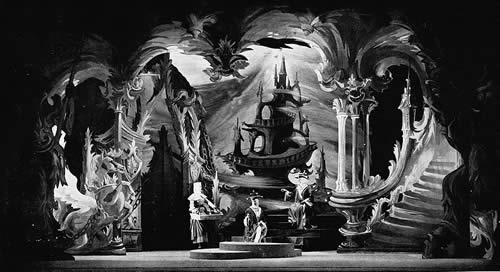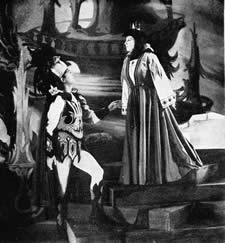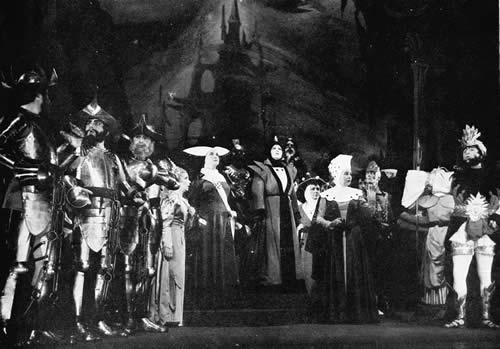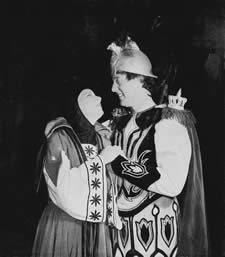 |
 |
||||||
Review from The Sphere, 2nd October 1954 by Jan Stevens.
It is a good thing not only to re-dress a classic every now and then, but also to restage it. Since the war the Company has provided Ruddigore with new scenery and costumes and The Mikado with new scenery, and this season is no doubt already memorable for the entirely new production of Princess Ida, which has not been performed by the professional company since July 1939.
Princess Ida last had new designs in 1922, and it may be that, but for the accident of war, there might have been no great urgency even now, on purely visual grounds, to supersede them. But in one of the early air raids all the scenery and costumes were destroyed, and when the time came at last to revive the piece it seemed to Miss Bridget D'Oyly Carte a suitable opportunity to put on a new production that would be in no sense a reconstruction of the old. Mr. Robert Gibson, the present producer, has been still more ambitious. The aim of this revival has been nothing less than the recovery of the mood of the fabulous dreamlike poem by Tennyson on which, the opera is based.
The new scenery and costumes have been more romantically beautiful than the old ones, and the attention of the audience has been directed, wherever possible, to the songs, and their often charming and tender words, rather than to the humorous dialogue, characteristic of the somewhat heavy-handed humour of the '70's, to which Gilbert's original play belongs.
But as a conscientious producer Mr. Gibson has not merely to deal with the opera in its final shape, but also with the short play of Gilbert's on which it was based, and with its source in the long poem by Tennyson.
In Tennyson's " The Princess " Gilbert recognised a plot ready made. The lady who turns her back on male society and resolves to devote herself, in the midst of a women's college founded by herself, to the pursuit of knowledge and the development of the feminine intellect, must have seemed to the jocular '70's a promising source of fun. At first, at any rate, that is certainly how even Gilbert saw Tennyson's heroine. But Tennyson had also provided him with the whole machinery of a comic play. There was the prince betrothed in childhood to the defaulting lady; there were the three young men disguised as girls in order to pass the closely-guarded gates of this feminist retreat; there were the lady's three brothers to complete the unity so necessary to farce; there were even a cross king and a good-natured one; and in the jealousy of the princess's middle-aged companion there was obviously heaven-sent fun of a sort very much to the popular taste of the time.
Working alone, and borrowing from various composers the music for his occasional interpolated songs, Gilbert brought out in 1870 what he called his " respectful per-version" of the poem. Like the poem, the travesty was called The Princess. It was produced at the old Olympic Theatre, and, as though it were not already farcical enough, the young men in it were played by young ladies. The Princess came, it succeeded, it passed away.
Fourteen years later Princess Ida arrived. In this the connection with Tennyson is no longer simple and direct, but complicated and devious. In the plot, Gilbert frugally made use of as much as possible of his burlesque. The work is now in three acts — Princess Ida, alone among the Savoy operas, has more than two — but, if we are to go by the plot alone, the general attitude is much the same. There are the same passages of extravagant humour, sometimes in the identical words of 1870, which convulsed audiences at the Olympic Theatre. To appreciate some of them even the fervent admirer of Gilbert must call upon a "sense of period" — for instance, in the account of the marriage of the infants before the opera opens. There is the same rather hearty fun at the expense of the aspirations of women, which was already beginning to date a little when the opera was first performed in 1885.
But the lyrics are not only new in fact, they are also entirely new in spirit. The older Gilbert, too frugal to abandon material so much of which could conveniently be used again, had, nevertheless, gone back to it with very different notions of what would tell in a theatre. Perhaps, too, he felt a belated regret for his previous coarsening of a charming and touching poem which had been, as it happened, far ahead of its time. Whatever the reason — and the influence of Sullivan may have had something to do with it — the piece as we know it contains some of Gilbert's most skilful and delightful lyrics.
Princess Ida's song in the third act, for example, "I built upon a rock," with its reproachful refrain, is an immeasurable advance on anything in the earlier piece. So, too, is Hilarion's lament in Act II,
| Whom thou has chained must wear his chain, | |
| Thou canst not set him free, | |
| He wrestles with his bonds in vain | |
| Who lives by loving thee! | |
That is lyrical in much more than the technical sense of the word. Even Cyril's "kissing song," in the same act, which discovers to the ladies the masquerade of Prince Hilarion and his friends, is charming.
This aspect of the opera, which may be called Gilbert's second thoughts on Tennyson, has been emphasised in the new production. In recruiting the services of Mr. James Wade as his designer, Mr. Gibson has gone the right way about it. For Mr. Wade, like such other designers of today as Mr. Loudon Sainthill, understands our craving, in a functional and not particularly lovely age, for a romantic and faery beauty. And in Princess Ida he has been given a free hand. So far from being required to adhere to the traditional, he has not even been allowed to see the designs for the previous productions. As for the production as such, Mr. Gibson has sought to cut out what one calls "dead wood," the accretion of minor stage " business," not strictly relevant to the opera, which grew naturally out of the personality of previous performers, but does not necessarily suit the personalities of their successors. What is obviously excellent in the tradition has been retained, as it ought to have been, and the beat of the music must often dictate the kind of actions that best accompany it.
One of the great interests in the revival for every intelligent visitor to the Savoy Theatre during Princess Ida has been to see how far Mr. Gibson has been successful in combining what may well appear the irreconcilable qualities of Gilhort. and Tennyson If Gilbert's concession is the increased sensibility to be found in the lyrics written for the work in its final form, there is a hint in Tennyson of concessions on his part, too. In a letter to his Canadian editor, Tennyson wrote of his poem : "You have seen amongst other things that if women were ever to play such freaks, the burlesque and the tragic might go hand in hand. . ."
But whatever we think of this revival, its production is an important testimony to the determination of the D'Oyly Carte Opera Company not to be left behind when others may eventually decide to put on the operas in the professional theatre. The gradual recruitment of a younger company should itself be invigorating. The inclusion of new singers who have already made a name for themselves in the wider operatic field, such as Miss Victoria Sladen and Mr. Thomas Round, the leading players in Princess Ida, may discover even new pleasures in Sullivan's music.
Page modified 24 August 2019





